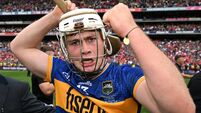The disappearance of Shergar ... 30 years on

EVEN before the kidnapping of Shergar on Feb 8, 1983, grabbed headlines around the world, the Irish new year had begun with ominous undertones.
In January, Malcolm MacArthur, the killer of nurse Bridie Gargan, had been sentenced to life — an individual whose actions brought into the Irish lexicon Gubu — ‘grotesque, unprecedented, bizarre and unbelievable’ — as defined by then Taoiseach, Charles Haughey.
In the North, tensions continued to run high, unemployment hit 16%, and mass emigration was once again rising as thousands headed to the US and Canada.
In a winter with little to cheer about, the exploits of Shergar were still a cause for national celebration, especially around Ballymany Stud in Kildare. The young stallion had become enshrined in Irish sporting folklore, having had one of the most extraordinary debut seasons in racing history in 1981, winning the Epsom Derby by a record distance, the first in a historic triple he added to with the Irish Derby and the King George.
With a telltale white blaze on his face, four white socks, and a distinctive racing style where his tongue stuck out one side of his mouth — “like a 10-year-old solving a tricky math problem” as one commentator put it — Shergar captured the imagination of the public like few thoroughbreds before or since. “He left the other horses for dead,” commentator Derek Thompson recalled. “He was surreal. He crossed that line of instant recognition where he wasn’t just a racehorse anymore, he was a superstar.”
When his owner, the Aga Khan, decided to retire the three-year old prodigy to his Kildare stud at the height of his glory in Sep 1981, a measure of his impact on Irish pride resulted in a civic reception in Newbridge, where he paraded the length of the town to the cheers of hundreds who turned out to applaud this remarkable creature.
Two years later, the five-year-old Shergar was about to enter his second season in stud when the audacious, and ultimately tragic, kidnapping happened on a foggy evening, 30 years ago this week.
Though he hadn’t raced in two years, the exploits of this ‘wonder horse’ still occupied much media space, now for his post-track success as a breeding stallion where he covered 35 mares in his first season at fees up to £80,000 a time. He was syndicated for £10m, divided into 40 shares worth £250,000 each, six of which the Aga Khan kept for himself.
Despite the ongoing troubles in the North, security around most stud farms in Ireland was minimal in those days, and Ballymany was no exception.
It was 8.30pm when head groom Jim Fitzgerald, 53, who lived at the stud, heard a knock on his door. When his son Bernard opened the door, three armed men wearing masks burst in. “We’re here for Shergar. We want £2m for him,” the terrified family were told.
Having begun his working life at Ballymany aged 16, Jim followed his father, also head groom before him. Succeeding his father in the late 1960s, he developed an instant affinity with the horse who would go on to create racing history. “It was easy to like Shergar,” he recalled. “He settled in well and he was a nice horse to do anything with. We cared for them all to the best of our ability.”
The raiders led him into the stable yard at gunpoint, as his wife Madge and the two youngest of their six children, Patrick, 8, and Gillian, 5, were held in the house.
Moving quickly, they led Shergar to a horsebox attached to a waiting car with four other gang members inside, while the head groom was bundled into a second vehicle. His wife was warned her husband would be killed if she gave the alarm. Mr Fitzgerald remembers most of the gang being in a state of excitement, brandishing guns and shouting abuse. “All sorts of thoughts were racing through my head about what they might do to me. One of them, with a revolver, was very aggressive.” He also remembers one of them saying “sorry” to him.
Driven around the back roads of Kildare for over three hours, Mr Fitzgerald was finally released just outside Kilcock village, about 30km from Ballymany. “They told me not to look back, and I didn’t,” he recalled.
“I was just happy to be on the ground.”
Walking into the town, he telephoned his brother, Des, to collect him. Returning to the stud just before midnight to find his family shaken but safe, he then rang the French stud manager, Ghislain Drion, who immediately called Stan Cosgrove, Shergar’s vet and a member of the owning syndicate.
Mr Cosgrave then rang Captain Seán Berry, chairman of the Irish Thoroughbred Breeders’ Association, who in turn phoned his neighbour, the recently appointed finance minister, Alan Dukes.
“They were obviously in a very agitated state,” Mr Dukes recalled. “The horse had disappeared and nobody knew where it was gone. I said they should call the police immediately which they did pretty soon after that.”
Given that Dukes was due to present his very first budget later that morning, he was keen to pass the reins of this groundbreaking event to other, more appropriate, hands. “I was woken up at three in the morning and you’re not too lucid in those circumstances, but I knew I wanted to have this particular chalice pass from me, so I said who I can shift the burden to?” The obvious choice was his colleague Michael Noonan, the recently appointed justice minister.
Time was of the essence, and gardaí were a vital eight hours behind the events. The kidnappers could have been anywhere in the country, or even overseas, by the time the gardaí were finally notified. The difficulties were compounded by the timing of the raid — happening on the same day as the biggest horse sale of the year at the nearby Goff’s. With dozens of horseboxes already travelling on the roads and lanes of Leinster, the raiders and their precious cargo had already become the proverbial pin in the haystack for their pursuers.
While appeals were made to farmers to check their outbuildings and lands for suspicious vehicles or activity, it served only to compound the logistics with numerous sightings and theories wasting vital police time.
By the afternoon of the following day, the story was making news headlines around the world. Within days, crews and reporters from all the major global news agencies were descending on Newbridge.
One of those who emerged as a personality was Inspector Jim ‘Spud’ Murphy, the local garda in charge of the case. “A stallion cannot be kept by people who are not well up in the horsey field,” he told the world’s press reporters.
On another occasion, he said: “We have got a good description, but what we haven’t got is a clue.” With his trademark trilby hat, he earned the soubriquet ‘Inspector Clouseau’. At one point, he confided that the gardaí were open to outside help with their enquiries: “We are working with diviners, clairvoyants, and psychics, we must be running up to 50 in all three categories at this point.”
While Insp Murphy provided some light relief in a search yielding no clear answers, much media speculation focused on the possibility that the Dublin and Kildare forces reportedly refused to share information and believed they were in direct competition.
In a case that became as baffling as it was bizarre, two groups of kidnappers appeared to emerge over the following days. Within hours of the abduction in Kildare, Co Down horse breeder, Judy Maxwell, received a phone call from an individual claiming to have Shergar and demanding a £40,000 ransom. This was followed by a call to the BBC in Belfast, asking that three, well-known racing journalists — John Oaksey of the Sunday Telegraph, Peter Campling from The Sun, and ITV’s Derek Thompson — would come to Belfast to negotiate. All three turned up at The Europa Hotel, as instructed, to receive a call from an anonymous voice directing them to the Maxwells’ farm. Eventually, they received a call at 3am telling them all negotiations had been cancelled as there had been an accident and Shergar was dead.
Meanwhile, across the border at Ballymany Stud, another anonymous individual using the code name, King Neptune, which had been given to Mr Fitzgerald during his abduction, opened another negotiation. He demanded £2m and a number for the Aga Khan’s office in Paris. Numerous calls to Paris followed, but as the Aga Khan’s office needed unanimous agreement from Shergar’s diverse syndicate, it proved impossible to reach an agreement. Paying any ransom would give out the wrong message, went the thinking, all other studs in Ireland’s bloodstock industry would be under threat. “They’re asking for £2m, but they won’t get 2m farthings,” said racing commentator John McCricrick. “The Aga Khan is in no position to pay them.”
In another twist, Ballymany vet and syndicate member Stan Cosgrove was told to go to the Crofton Hotel in Dublin and pick up an envelope using the name of Eurovision winner, Johnny Logan. The envelope contained a picture of Shergar’s head next to a current copy of a Belfast newspaper.
However, the Aga Khan’s office was not satisfied and demanded a full standing shot of the horse as ultimate assurance he had not been harmed. No such photograph was ever forthcoming. It marked the end of the negotiations, and the last contact made by the kidnappers.
After 30 years, the mystery of what happened ‘the world’s greatest racehorse’ seems no closer to being solved.
Theories over who had kidnapped Shergar have been as plentiful as they were fanciful over the years. Libyan dictator Muammar Gaddafi figured prominently in the early days, with some suggesting the IRA had kidnapped the horse in return for weapons.
Others suggested Gaddafi wanted Shergar to enhance his profile as part of his plan to become leader of the Islamic people, rather than the Aga Khan, the direct descendant of the prophet Mohamed.
Another theory involved the US Mafia, who had loaned French bloodstock dealer Jean Michel Gambet a substantial sum to purchase a horse from the Aga Khan. The deal eventually collapsed, with Gambet having gambled away the mob’s money. He was eventually found shot through the head in a car in Kentucky.
The Mafia still believed they were owed a horse and farmed out the kidnap of Shergar to local criminals in Ireland.
Like an equine Lord Lucan, sightings of Shergar emerged for many years after his kidnapping. Fanciful tales of the horse being put to stud at secret locations in the Middle East competed with stories he had been smuggled to Asia as the personal pet of a billionaire.
On one occasion, a horse’s head with two bullet holes was discovered in undergrowth at Foley’s Glen, outside Tralee, during a clean-up operation. But forensic testing proved it was the head of a two-year-old.
Much credence is given to former IRA member-turned-informer Seán O’Callaghan’s belief that Shergar was shot within hours of being kidnapped after he became aggressive in the horsebox and broke his leg.
Tallying with that phone call to the Maxwells’ stud the day after the kidnap saying the horse was dead, his comments carry some weight.
“They had to kill him because they obviously couldn’t call a vet, they had the most recognisable horse in the world on their hands,” he said.
“It was a total cock-up from start to finish.”












